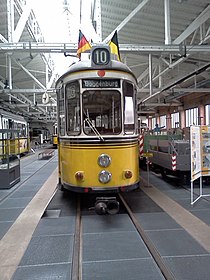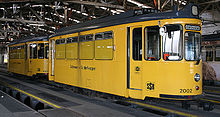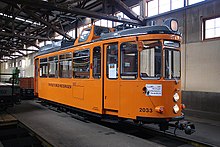SSB T2
| SSB T2 | |
|---|---|
|
T2 number 804 in the Stuttgart Tram World
|
|
| Numbering: | 701-823 |
| Number: | 118 |
| Manufacturer: | Machine factory in Esslingen |
| Year of construction (s): | 1954-1957 |
| Gauge : | 1000 mm ( meter gauge ) |
| Motor type: | DC motor |
| Power system : | 600 V DC |
| Power transmission: | Overhead line |
| Drive: | Electric drive |
| Coupling type: | Scharfenberg coupling |
The T2 is a two-axle tram - railcar of the Stuttgarter Straßenbahnen AG built by the machine works Esslingen . It is also called Type 29. The vehicles delivered from 1954 to 1957 were the last two-axle vehicles built for the Stuttgart tram. Three identical vehicles were also delivered to the Reutlingen tram . Sidecars of the appropriate type B2 were also delivered to Stuttgart and Reutlingen.
In 1964, 70 T2 were converted into double multiple units of the DoT4 type by connecting two vehicles each with a middle section. The railcars were in use in this form until 1985.
The last unmodified T2 were retired in 1976. With the exception of type 29.5 railcar 802, which remained with the SSB as a roadworthy museum car. The railcar 804, which was almost in the delivery state in 1976 and also belongs to the 29.5 type, was initially stored in Ostheim at the instigation of some tram enthusiasts and is now part of the inoperable inventory of the Stuttgart Tramway World .
In addition, some T2 and B2 were sold to the tram in Mülheim an der Ruhr in the early 1970s , where they remained in use until the early 1980s. The Ulm tram did not acquire any railcars, but some sidecars that were used there until the end of the 1980s.
The two grinding carts
In 1973 the railcars 822 and 823 were converted into grinding cars by SSB and Schörling and are still in use today as cars in 2002 and 2003. In the course of the renovation, the interior fittings in the passenger compartment were removed. Instead, water tanks for cooling or to prevent flying sparks during the grinding process as well as other units were housed inside the car.
Grinding is carried out in the so-called sliding stone operation, where two grinding stones are pressed on each side of each railcar on the rail head and this is then ground during the journey. In order to achieve a better grinding result, the two railcars usually run in multiple units .
Up until a general inspection in 1995, the cars were painted in traffic orange. They left the main workshop in gorse yellow and a control system adapted to the GT4. Despite the discontinuation of meter-gauge tram operations in December 2007, they are still in operation and maintain the rails along the two museum lines 21 and 23.
The contact line test vehicle
In addition, the railcar 2033 (formerly 815) is still in the inventory. The car, which was converted into a contact line measuring vehicle in 1975, was equipped with an observation cockpit on the B-side to check the height and lateral position of the overhead contact line while driving. The car also has the option of measuring the contact wire voltage and also has a static inverter from 600 or 750 to 220 volts. In 1997 the car was assigned to the Tram Museum , known today as the Stuttgart Tram World, for shunting and transport tasks. Since 2008 the vehicle has been part of the inoperable inventory of the Stuttgart Tram World.
The individual deliveries
| Type | Years of construction | Company numbers | Factory numbers |
|---|---|---|---|
| 29.1 | 1954 | 751-777 | 23576-23602 |
| 29.2 | 1954-55 | 778-794 | 23728-23744 |
| 29.3 | 1955 | 701-710 711-740 |
23718 - 23727 23796 - 23825 |
| 29.4 | 1955 | 741-750 | 23851-23860 |
| 29.5 | 1956-57 | 795-823 | 24861-24889 |
literature
- Gottfried Bauer, Ulrich Theurer, Claude Jeanmaire: The vehicles of the Stuttgart trams , Verlag Eisenbahn, Villigen 1979, ISBN 3-85649-033-7 .
Web links
- http://www.shb-ev.de
- http://www.ssimodellbahntechnik.de/ssihomepage/T2.html The T2 as original and model



